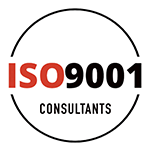ISO 9001 Preparation

Set your goals
There are many operational and marketing benefits to acquiring ISO 9001 certification. However, it is important to understand that just by deciding to get the certificate, you will not “automatically” achieve these benefits. Hence, you need to customise the requirements of the certificate to your organisation’s unique circumstances.
This can be done by setting realistic, attainable and customised goals. Therefore, the start of your ISO certification journey begins by defining the benefits that you want to gain by acquiring ISO 9001 certificate. It is recommended to begin by focusing on operational rewards, going on to convert them into simplified yet tangible objectives.
How to set goals?
By implementing the following points, you can create goals that can be customised to the unique needs of your organisation:
- Identify current deficiencies and problems.
- Develop a list of potential benefits and prioritise them as per their relevance.
- Convert these potential benefits into smart-measurable-attainable-realistic-timely (SMART) goals.
- Identify action steps that need to be taken to achieve these goals.
- Monitor the progress of these action steps and communicate your success across the organisation.
Some important points for setting goals in the organisation
Setting targets and objectives should involve inputs from individuals that are in relevant functional areas of your organisation.
Gathering inputs from relevant individuals with experience helps to establish, plan and achieve the targets. Moreover, the involvement of your employees helps you to build commitment, enhance engagement rates and demonstrate transformational leadership.
- It is necessary for the top management to fully commit to the development of the quality objectives. The involvement of the leaders of an organisation ensures that adequate resources are applied and the objectives are well-integrated with the other organisational goals.
- Communicate the quality objectives to your employees. It is necessary to link the objectives with actual quality improvements that an organisation is attempting to achieve. It is extremely motivating for employees as they now have a tangible focus to align their efforts. Examples of such quality improvements include closing out the corrective actions or reducing non-conformances.
- It is necessary to ensure that the quality objectives are consistent with the overall mission of the organisation and key commitment points have been established in your policy.
- It is necessary to ensure that your objectives are not rigid, and have some amount of flexibility. For example, it is helpful to define the desired outcome, but remain flexible by allowing people to find innovative ways to achieve this result.
- Objectives can be made to improve performance or to maintain the current levels of performance.
- It is extremely motivating to communicate the progress you have achieved with respect to your objectives and targets across the organisation. This can be done through regular reports at staff meetings.
- There are no set rules on the number of objectives or targets that an organisation should have. Depending upon the size of your organisation, the number of objectives can vary. However, it is recommended that for medium-sized to small industries, QMS implementation projects should start with a limited number of objectives, say, between 3 to 5, going on to expand the list after achieving the original targets.
- It is helpful to exponentially grow your objectives. This means that initially, you should keep your quality objective simple, and then after gaining some success, go on to build them.
- When creating your objective, it is helpful to keep your suppliers in mind. Thinking about the suppliers of your materials or services can help you create realistic objectives that can be achieved within attainable time periods.
Before you begin to create your objectives, it is important to ensure that your organisation has appropriately identified both internal and external issues that impact the quality of its products/services. Additionally the needs of all interested parties should also be incorporated when attempting to create objectives that support the strategic direction of your organisation. Moreover, the strategic direction of the organisation must be used as a guide when creating the policy, objectives, risk management plans, monitoring and measurement tactics.
Define the scope
It may become overwhelming to apply ISO 9001 recommendations to every part of your organisation. By excluding specific departments, locations or products, you can enhance the efficiency and time of your certification process. Alternatively, you can roll out your certification process gradually, beginning with the functions that are the most relevant. However, since each organisation is unique, the pros and cons of limiting the scope statement need to be carefully analysed. There are many benefits gained from uniformly and gradually applying the ISO 9001 standard across your organisation.
Why is the scope important?
The scope is helpful in guiding the registrar to determine which areas need auditing. Within the scope statement, you should state the types of products or services you offer. Additionally, it is important to give a justification for requirements that are not applicable to your organisation. For example, if you do not design your own products, make a clear statement of exclusion in your scope statement.
Similarly, if your company has several facilities, provide a list of all the locations that have been included or excluded from the quality management scope. Another example is that if you manufacture toys, then the scope statement should include the primary functions of all toys produced, in addition to the specific location in your business where they are stored and how these toys are distributed to the target audience. A common mistake that companies make in implementing an ISO scope is that they write it without a valid direction. Remember, the scope is not just a bureaucratic statement that is created for acquiring compliance, rather a useful guide that can aid you in your future endeavours. You should not create one for the sake of creating one, or do it half-heartedly. The scope statement is essentially a roadmap to help in the implementation and evaluation of a QMS.
Avoid these mistakes in writing the scope
- Avoid over-complicating the system: Over-complicating the business is counterproductive for your system. Is your business struggling to keep the system alive? Perhaps, one of the reasons why your system is struggling for survival is that it is too complex and the documenting procedures are not adding any “real” value to your organisation. Here, it would be greatly helpful to simplify the system and focus on practicality. The best idea is to emphasise on improvement and focus on desired results, instead of getting bogged down by documentation.
- Rushing into writing the scope: An unfortunate mistake that many companies commit is that they rush into writing their scope. If you want a scope that is superficial, then you should not spend much time on it. However, if you want a concrete ISO scope statement, that is effective, strategic and helpful for your organisation, then you need to spend time developing it. Reducing the time for drafting the scope statement will hamper the efficiency of your QMS. Do not be disheartened if it takes too much time and give yourself the liberty to revise it until it perfectly suits the requirements of your organisation. A well-defined scope statement also helps in improving the quality of your products and services, and makes the QMS implementation process hassle-free.
- Not understanding the requirements of the clients: The main focus of ISO 9001 is to enhance customer satisfaction. This is why it is necessary to understand customer requirements before actually writing the scope statement. Hence, you have to ask yourself this crucial question: do you really take out the time to listen to your customer, and go through their feedback? If your answer is yes, then you are already in a position to achieve your goals. Here, it is helpful to remember that to obtain customer feedback, you do not need to conduct a complex customer survey. You can simply ask a few questions to gather the sufficient inputs that are necessary to make the required changes, so that your objectives can be met.
- Not having the right resources: Without the adequate resources, your likelihood of encountering quality problems increases. One such example is when incompetent personnel with inadequate experience creates the scope, then the scope statement becomes ineffective in determining the boundaries and applications of the QMS. Hence, before writing the scope statement, ask yourself if the working space is large enough, is the equipment reliable, is the current working environment hindering the process of creating the scope or does it degrade the products.
- Failure to properly utilise the corrective action process: It is necessary for your organisation to take out time to introspect and identify the underlying problems in your quality management. This can be done by engaging with the right people in your processes. If the root cause is not identified, it reduces the effectiveness of the corrective action processes, and enhances redundancy. In contrast, effective evaluation leads to effective application of the corrective action process, which leads to elimination of redundancy.
- Lack of an experienced auditor: In majority of the cases, the internal auditors do not have the right experience or training to differentiate between major and minor issues as per ISO requirements. Training helps auditors to focus on issues that can hinder the certification process, that negatively impact the compliance as well as identify areas of improvement.
- Not having a unique plan: Every organisation is unique, meaning that its needs, circumstances, products, services and people are not similar to another organisation. Therefore, it is futile to copy the scope statement of another organisation.
- Leaving it to one individual: Scope creation is a joint effort and the entire organisation must be involved in its development. This means that every stakeholder should take ownership of the quality management system and provide their input. This is because, unless the employees of the organisation share their valuable input about the daily operations, no outsider can help the organisation identify the quality-related issues.
Who is responsible?
Irrespective of how you plan to pursue your certification, your organisation needs an ISO 9001 management representative, an individual who is responsible for achieving and maintaining the certificate. Many a times, it is the quality manager executive who becomes the ISO 9001 management representative, but anyone with sufficient experience and authority to implement operational processes can become one.
We recommend a decentralised approach to companies with multiple locations, where local management representatives are appointed. If this step is done right, it allows the organisation to enhance their flexibility and simplicity.
Get training
If you are in-charge of managing your organisation’s quality management system, then it makes sense to become familiar with the ISO 9001:2015 standard by understanding its requirements and how they can be interpreted in your company. This will help you to appropriately plan and execute the implementation process.
To get started with ISO 9001, here are a few pointers:
- Familiarise yourself with the requirements of the ISO 9001 standard.
- Plan out the details for your implementation process.
- Identify and determine the necessary responsibilities, policies and objectives.
- Develop your documentation procedure.
- Launch your quality management system.
- Evaluate your performance.
- Based on your evaluation, register for the certification.
- Create an environment for continual improvement.
Gain executive support
Do not underestimate the importance of leadership in the implementation of the QMS. The leaders of an organisation play an important role in the development, maintenance and improvement of the ISO 9001 standard. It is critical that the support of the top management is real and concrete. The first step in acquiring active support from the management is through the provision of the necessary knowledge.
As an experienced manager in ISO 9001, teach the leaders of your organisation about their role in ISO 9001. Top management needs to establish, review and maintain the quality policy, in addition to ensuring that it is applied evenly across the organisation. Members of the management also need to ensure that the authorities and responsibilities for relevant roles are assigned, communicated and assimilated within the organisation.
Create enthusiasm
When new procedures are implemented within an organisation, the chances of resistance can increase. Therefore, it is necessary to create enthusiasm and inform your staff about the upcoming changes before rumours begin. In order to create enthusiasm, it is helpful to show how ISO 9001 certification will not only benefit the organisation, but also each employee. Discuss the positive effects of the standard on work processes, job security and employee satisfaction. Moreover, motivation can also increase by involving people into the project.
How to create enthusiasm?
- Introduce ISO 9001 to your employees.
- Discuss the purpose and benefits of the standard.
- Describe the benefits of the quality management system, and how it adds value to your company’s operations.
- Discuss the benefits that the standard brings to the employees.
- Give a heads-up about upcoming internal and external audits.
- Prepare employees for certification audit and how to interact with the auditors with mock-interviews.
Conduct a gap analysis
Many companies find it useful to conduct a gap analysis to measure the extent to which their organisation is already in compliance with the standard, and where deficiencies exist. The results of the gap analysis will help you identify where implementation efforts should focus.
As a result of the gap analysis, you will be able to prepare a customised project plan that has more accurate target dates and attainable milestones. In fact, many ISO consultants utilise the gap analysis to familiarise them with the manner in which your company operates. Essentially, a gap analysis is a survey that utilises a checklist to determine the deficiencies between a company’s existing business system and the requirements outlined in the applicable standard.
Gap analysis benefits
A gap analysis will help your organisation save valuable effort and time. Instead of stumbling across endless channels of paperwork, a gap analysis will provide you with a structured roadmap to begin your ISO 9001 certification journey. A lot of time is saved as you understand where your company is falling short, allowing you to focus your efforts in improving those areas, instead of being swarmed by a truckload of documentation. Moreover, a gap analysis can also increase your cost savings in the long run. Although, it is true that hiring a professional consultant or purchasing a gap analysis checklist costs money, but, running a gap analysis without experience will be more expensive in the long run. The cost of hiring an ISO consultant is justified because of the value they provide.
How to conduct a gap analysis ?
Even though the process of becoming ISO 9001 certified is complicated, the process of conducting a gap analysis can be considered to be a little less complicated. There are six major steps for conducting a gap analysis in accordance to ISO 9001, they include:
- Assigning appropriate responsibilities.
- Purchasing or creating a gap analysis checklist.
- Scheduling the gap analysis.
- Learning how to perform a gap analysis.
- Collecting, reviewing and reporting the findings.
- Implementing the corrective actions to improve the QMS.
Plan your project
It is highly recommended to keep your project planning simple by focusing on implementation steps, attainable milestones and achievable dates. Additionally, it is helpful to delegate responsibilities to the right individuals. Another recommendation is to avoid gantt chart and other similar types of complexities if you are a small to mid sized company.
Sample of project planning
Project plan: ISO 9001:2015
Project goals
Start date: .___________
Target registration date: ___________
Responsibilities: ___________
Project manager: ___________
Quality Management Representative: ___________
Person ultimately in-charge of the QMS: ___________
ISO 9001:2015 team: ___________
Project timelines: ___________
contact us
Preparing for ISO 9001 certification is a difficult and challenging process. We can help you prepare for the ISO 9001 audit and certification in the shortest possible time. Just call us.
FAQ
- Be well-prepared. …
- Take internal audits seriously. …
- Implement corrective actions. …
- Don’t forget your management review. …
- Correctly monitor objectives. …
- Ensure that everything is clean.
you can learn more in this article.
- Step 1: Preparing Yourself. If you are not familiar with the certification process, everything needs to be done officially. …
- Step 2: Documentation of ISO 9001 QMS. …
- Step 3: QMS Implementation. …
- Step 4: Internal Audits. …
- Step 5: ISO 9001 Certification.
you can learn all things about iso 9001 on our website.













